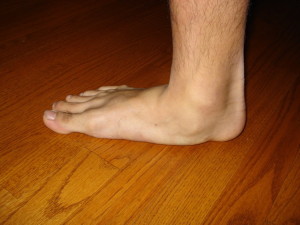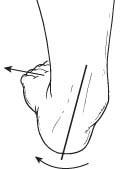
What Is Flatfoot?
Flatfoot is often a complex disorder, with diverse symptoms and varying degrees of deformity and disability. There are several types of flatfoot, all of which have one characteristic in common: partial or total collapse (loss) of the arch.
Other characteristics shared by most types of flatfoot include:
- “Toe drift,” in which toes(usually 3rd/4th/5th toes) are visible from behind.
- The heel tilts toward the outside and the ankle appears to turn in.
- A tight Achilles tendon, which causes early heel lift during the gait cycle and over time problems may worsen.
- Bunions, hammertoes and Morton’s neuroma may develop as a result of a flatfoot.
Flexible Flatfoot
Flexible flatfoot is one of the most common types of flatfoot. It typically begins in childhood or adolescence and continues into adulthood. It usually occurs in both feet and progresses in severity throughout the adult years. As the deformity worsens, the soft tissues (tendons and ligaments) of the arch may stretch or tear and can become inflamed.
The term “flexible” means that while the foot is flat when standing (weight-bearing), the arch returns when not standing.
Note: A flat foot is normal in infants and toddlers because the foot’s arch hasn’t yet developed.

Adult Acquired Flatfoot (Posterior Tibialis Tendon Dysfunction)
The posterior tibial tendon serves as one of the major supporting structures of the foot, helping it to function while walking. Posterior tibial tendon dysfunction (PTTD) is a condition caused by changes in the tendon, impairing its ability to support the arch. This results in flattening of the foot.
PTTD is usually progressive, which means it will keep getting worse and bony adaptation takes in a place causing arthritic changes in the major foot and ankle joints, especially if it isn’t treated early.
Symptoms
Symptoms may occur in some persons with flexible flatfoot:
- Pain in the heel, arch, ankle, or along the outside of the foot.
- “Rolled-in” ankle (over-pronation).
- Pain along the shin bone (shin splint).
- General aching or fatigue in the foot or leg.
- Low back, hip or knee pain.
The symptoms of adult-acquired flatfoot (PTTD) varies depending on the severity of the disease but typically include pain, swelling, a flattening of the arch, and an inward rolling of the ankle.
Stage 1: Pain on the inside of the foot and ankle (along the course of the tendon)
The area may be red, warm, and swollen
Stage 2: Increased pain on the inside of the foot and ankle
The foot and toes begin to turn outward and the ankle rolls inward
The area may be more red, warm, and swollen
Stage 3: Pain often shifts to the outside of the foot
The arch even more flattened
Severe Tendon Degeneration(No longer Functioning)
Bony Adaptation(Arthritic changes in foot and ankle joints)
Treatments of Flexible Flatfoot
If you experience symptoms with flexible flatfoot, non-surgical treatment options include;
- Activity modifications. Reduce weight-bearing activities that cause pain and avoid prolonged walking and standing to give your arches a rest.
- Weight loss. If you are overweight, try to lose weight.
- Orthotic devices. We can provide you with custom-made full functional orthotic devices for your shoes to give more support to the arches.
- Immobilization. In some cases, it may be necessary to use a walking cast or to completely avoid weight-bearing.
- Medications. Nonsteroidal anti-inflammatory drugs (NSAIDs), such as ibuprofen, help reduce pain and inflammation.
- Physical therapy. Ultrasound therapy or other physical therapy modalities may be used to provide temporary relief. We can work with our excellent in-house physiotherapists to offer you the best treatment.
- Shoe modifications. Wearing shoes that support the arches is important for anyone who has flatfoot.
In some patients with flexible flatfoot whose pain is not relieved by conservative treatments, surgery may be considered. A variety of surgical techniques is available to correct flexible flatfoot, and one or a combination of procedures may be required to relieve the symptoms and improve foot function.
Treatments of Adult Acquired Flatfoot (PTTD)
Due to the progressive nature of PTTD, early treatment is advised. If treated early enough, your symptoms may resolve without the need for surgery and the progression of your condition can be arrested.
However, if untreated, PTTD could leave you with an extremely flat foot, painful arthritis in the foot and ankle, and increasing limitations on walking, running, or other activities.
In many cases of PTTD, treatment can begin with non-surgical approaches that may include:
- Orthotics or bracing. To give your arch the support it needs, we may need to provide you with an ankle brace or a custom orthotic device that fits into the shoe.
- Immobilization. Sometimes a short-leg cast or boot is worn to immobilize the foot and allow the tendon to heal.
- Physical therapy. Ultrasound therapy and exercises may help rehabilitate the tendon and muscle following immobilization. We can work with our excellent in-house physiotherapists to offer you the best treatment.
- Medications. Nonsteroidal anti-inflammatory drugs (NSAIDs), such as ibuprofen, help reduce pain and inflammation.
- Shoe modifications. Your foot and ankle surgeon may advise changes to make with your shoes and may provide special inserts designed to improve arch support.
In cases of PTTD that have progressed substantially or have failed to improve with non-surgical treatment, surgery may be required. For some advanced cases, surgery may be the only option. Dr Timmins will determine the best approach for you.


